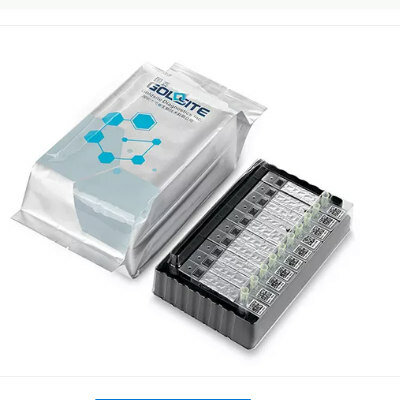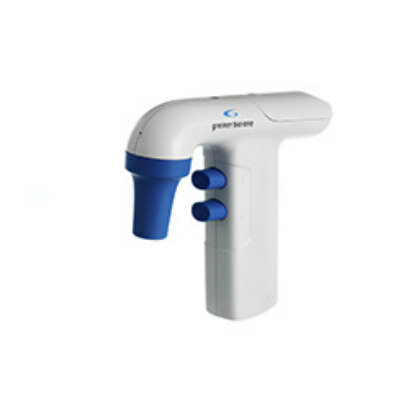Respiratory Syncytial Virus Bronchiolitis Has Different Subtypes
|
By LabMedica International staff writers Posted on 30 Jun 2021 |

Image: The Bioanalyzer RNA 6000 Nano assay provides reliable and reproducible characterization of total RNA and mRNA from multiple sample types, from as low as 5 ng of total RNA (Photo courtesy of Agilent)
Bronchiolitis is the leading cause of hospitalization in infants in the USA, accounting for about 110,000 hospitalizations annually. In addition to the substantial acute morbidity, around 30% of infants hospitalized for bronchiolitis (“severe bronchiolitis”) subsequently develop asthma in childhood.
Of the major causative pathogens, respiratory syncytial virus (RSV) infection during infancy has the largest population attributable fraction. While bronchiolitis has been considered a single disease with similar mechanisms, emerging evidence suggests heterogeneity in clinical presentations and chronic morbidities (e.g., subsequent risk of recurrent wheeze and asthma).
Medical Scientists at the Massachusetts General Hospital (Boston, MA, USA) and their colleagues analyzed the data from a multicenter prospective cohort study of infants hospitalized for bronchiolitis. This prospective cohort study completed enrollment of 1,016 infants (age < 1 year) hospitalized with bronchiolitis at 17 sites across 14 USA states. Of these 1,016 infants (median age, 3 months; female, 40%), 921 (91%) completed the run-in procedure.
The team isolated total RNA from the nasopharyngeal samples using Trizol LS reagent (ThermoFisher Scientific, Waltham, MA, USA) in combination with the Direct-zol RNA Miniprep Kit (Zymo Research, Irvine, CA, USA). RNA quantity was measured with the (ThermoFisher Scientific Qubit 2.0 fluorometer and its quality was assessed with the Agilent Bioanalyzer 2100 (Agilent, Palo Alto, CA, USA) using the RNA 6000 Nano kit.
To provide further insights, the team analyzed diverse clinical, genetic, and molecular data from 221 infants hospitalized with RSV bronchiolitis who were followed until age 5 years. They gathered information on the viruses that had infected the children, as well as information on the microbes, metabolites, and immune response-related molecules present in the children’s nasal passages.
The scientists reported that based on their analyses, four biologically and clinically meaningful subtypes, or endotypes, of RSV bronchiolitis exist. Of these, 1 endotype, which is characterized by coinfection by rhinovirus, dominance by specific bacteria, and high interferon (IFN) response, had an approximate 40% risk of developing asthma by age five.
The investigators identified four biologically- and clinically-meaningful endotypes: “(1) clinicalclassicmicrobiomeM nonliquefaciensinflammationIFN-intermediate; (2) clinicalatopicmicrobiomeS pneumoniae/M catarrhalisinflammationIFN-high; (3) clinicalseveremicrobiomemixedinflammationIFN-low; and (4) clinicalnon-atopicmicrobiomeM.catarrhalisinflammationIL-6. Particularly, compared with endotype A infants, endotype B infants, had a significantly higher risk for developing asthma (9% versus 38%).
Yoshihiko Raita, MD, an Emergency Medicine physician and first author of the study, said, “Our data add significant support to the emerging concept that bronchiolitis represents several diseases with unique biological mechanisms. For clinicians, our findings give an evidence base for the early identification of high-risk children during an important period of airway development, early infancy.
The authors concluded that by applying an integrated omics approach to data from a multicenter prospective cohort study of 221 infants with RSV bronchiolitis, they had identified four biologically distinct and clinically meaningful endotypes. The study was published on June 14, 2021, in the journal Nature Communications.
Related Links:
Massachusetts General Hospital
ThermoFisher Scientific
Zymo Research
Agilent
Of the major causative pathogens, respiratory syncytial virus (RSV) infection during infancy has the largest population attributable fraction. While bronchiolitis has been considered a single disease with similar mechanisms, emerging evidence suggests heterogeneity in clinical presentations and chronic morbidities (e.g., subsequent risk of recurrent wheeze and asthma).
Medical Scientists at the Massachusetts General Hospital (Boston, MA, USA) and their colleagues analyzed the data from a multicenter prospective cohort study of infants hospitalized for bronchiolitis. This prospective cohort study completed enrollment of 1,016 infants (age < 1 year) hospitalized with bronchiolitis at 17 sites across 14 USA states. Of these 1,016 infants (median age, 3 months; female, 40%), 921 (91%) completed the run-in procedure.
The team isolated total RNA from the nasopharyngeal samples using Trizol LS reagent (ThermoFisher Scientific, Waltham, MA, USA) in combination with the Direct-zol RNA Miniprep Kit (Zymo Research, Irvine, CA, USA). RNA quantity was measured with the (ThermoFisher Scientific Qubit 2.0 fluorometer and its quality was assessed with the Agilent Bioanalyzer 2100 (Agilent, Palo Alto, CA, USA) using the RNA 6000 Nano kit.
To provide further insights, the team analyzed diverse clinical, genetic, and molecular data from 221 infants hospitalized with RSV bronchiolitis who were followed until age 5 years. They gathered information on the viruses that had infected the children, as well as information on the microbes, metabolites, and immune response-related molecules present in the children’s nasal passages.
The scientists reported that based on their analyses, four biologically and clinically meaningful subtypes, or endotypes, of RSV bronchiolitis exist. Of these, 1 endotype, which is characterized by coinfection by rhinovirus, dominance by specific bacteria, and high interferon (IFN) response, had an approximate 40% risk of developing asthma by age five.
The investigators identified four biologically- and clinically-meaningful endotypes: “(1) clinicalclassicmicrobiomeM nonliquefaciensinflammationIFN-intermediate; (2) clinicalatopicmicrobiomeS pneumoniae/M catarrhalisinflammationIFN-high; (3) clinicalseveremicrobiomemixedinflammationIFN-low; and (4) clinicalnon-atopicmicrobiomeM.catarrhalisinflammationIL-6. Particularly, compared with endotype A infants, endotype B infants, had a significantly higher risk for developing asthma (9% versus 38%).
Yoshihiko Raita, MD, an Emergency Medicine physician and first author of the study, said, “Our data add significant support to the emerging concept that bronchiolitis represents several diseases with unique biological mechanisms. For clinicians, our findings give an evidence base for the early identification of high-risk children during an important period of airway development, early infancy.
The authors concluded that by applying an integrated omics approach to data from a multicenter prospective cohort study of 221 infants with RSV bronchiolitis, they had identified four biologically distinct and clinically meaningful endotypes. The study was published on June 14, 2021, in the journal Nature Communications.
Related Links:
Massachusetts General Hospital
ThermoFisher Scientific
Zymo Research
Agilent
Latest Pathology News
- Spatial Tissue Analysis Identifies Patterns Associated With Ovarian Cancer Relapse
- Unique Hand-Warming Technology Supports High-Quality Fingertip Blood Sample Collection
- Image-Based AI Shows Promise for Parasite Detection in Digitized Stool Samples
- Deep Learning Powered AI Algorithms Improve Skin Cancer Diagnostic Accuracy
- Microfluidic Device for Cancer Detection Precisely Separates Tumor Entities
- Virtual Skin Biopsy Determines Presence of Cancerous Cells
- AI Detects Viable Tumor Cells for Accurate Bone Cancer Prognoses Post Chemotherapy
- First Ever Technique Identifies Single Cancer Cells in Blood for Targeted Treatments
- Innovative Blood Collection Device Overcomes Common Obstacles Related to Phlebotomy
- Intra-Operative POC Device Distinguishes Between Benign and Malignant Ovarian Cysts within 15 Minutes
- Simple Skin Biopsy Test Detects Parkinson’s and Related Neurodegenerative Diseases
- Bioinformatics Tool to Identify Chromosomal Alterations in Tumor Cells Can Improve Cancer Diagnosis
- Coin-Sized Device Rapidly Isolates Blood Plasma for Quicker and More Precise Clinical Diagnoses
- AI Predicts Cancer Spreading To Brain from Lung Biopsy Images
- Improved Microneedle Technology Speeds Up Extraction of Sample Interstitial Fluid for Disease Diagnosis
- AI Outperforms Expert Pathologists in Predicting Lung Cancer Spread
Channels
Clinical Chemistry
view channel
3D Printed Point-Of-Care Mass Spectrometer Outperforms State-Of-The-Art Models
Mass spectrometry is a precise technique for identifying the chemical components of a sample and has significant potential for monitoring chronic illness health states, such as measuring hormone levels... Read more.jpg)
POC Biomedical Test Spins Water Droplet Using Sound Waves for Cancer Detection
Exosomes, tiny cellular bioparticles carrying a specific set of proteins, lipids, and genetic materials, play a crucial role in cell communication and hold promise for non-invasive diagnostics.... Read more
Highly Reliable Cell-Based Assay Enables Accurate Diagnosis of Endocrine Diseases
The conventional methods for measuring free cortisol, the body's stress hormone, from blood or saliva are quite demanding and require sample processing. The most common method, therefore, involves collecting... Read moreMolecular Diagnostics
view channel
Unique Autoantibody Signature to Help Diagnose Multiple Sclerosis Years before Symptom Onset
Autoimmune diseases such as multiple sclerosis (MS) are thought to occur partly due to unusual immune responses to common infections. Early MS symptoms, including dizziness, spasms, and fatigue, often... Read more
Blood Test Could Detect HPV-Associated Cancers 10 Years before Clinical Diagnosis
Human papilloma virus (HPV) is known to cause various cancers, including those of the genitals, anus, mouth, throat, and cervix. HPV-associated oropharyngeal cancer (HPV+OPSCC) is the most common HPV-associated... Read moreHematology
view channel
Next Generation Instrument Screens for Hemoglobin Disorders in Newborns
Hemoglobinopathies, the most widespread inherited conditions globally, affect about 7% of the population as carriers, with 2.7% of newborns being born with these conditions. The spectrum of clinical manifestations... Read more
First 4-in-1 Nucleic Acid Test for Arbovirus Screening to Reduce Risk of Transfusion-Transmitted Infections
Arboviruses represent an emerging global health threat, exacerbated by climate change and increased international travel that is facilitating their spread across new regions. Chikungunya, dengue, West... Read more
POC Finger-Prick Blood Test Determines Risk of Neutropenic Sepsis in Patients Undergoing Chemotherapy
Neutropenia, a decrease in neutrophils (a type of white blood cell crucial for fighting infections), is a frequent side effect of certain cancer treatments. This condition elevates the risk of infections,... Read more
First Affordable and Rapid Test for Beta Thalassemia Demonstrates 99% Diagnostic Accuracy
Hemoglobin disorders rank as some of the most prevalent monogenic diseases globally. Among various hemoglobin disorders, beta thalassemia, a hereditary blood disorder, affects about 1.5% of the world's... Read moreImmunology
view channel
Diagnostic Blood Test for Cellular Rejection after Organ Transplant Could Replace Surgical Biopsies
Transplanted organs constantly face the risk of being rejected by the recipient's immune system which differentiates self from non-self using T cells and B cells. T cells are commonly associated with acute... Read more
AI Tool Precisely Matches Cancer Drugs to Patients Using Information from Each Tumor Cell
Current strategies for matching cancer patients with specific treatments often depend on bulk sequencing of tumor DNA and RNA, which provides an average profile from all cells within a tumor sample.... Read more
Genetic Testing Combined With Personalized Drug Screening On Tumor Samples to Revolutionize Cancer Treatment
Cancer treatment typically adheres to a standard of care—established, statistically validated regimens that are effective for the majority of patients. However, the disease’s inherent variability means... Read morePathology
view channel
Spatial Tissue Analysis Identifies Patterns Associated With Ovarian Cancer Relapse
High-grade serous ovarian carcinoma is the most lethal type of ovarian cancer, and it poses significant detection challenges. Typically, patients initially respond to surgery and chemotherapy, but the... Read more.jpg)
Unique Hand-Warming Technology Supports High-Quality Fingertip Blood Sample Collection
Warming the hand is an effective way to facilitate blood collection from a fingertip, yet off-the-shelf solutions often do not fulfill laboratory requirements. Now, a unique hand-warming technology has... Read moreTechnology
view channel
New Diagnostic System Achieves PCR Testing Accuracy
While PCR tests are the gold standard of accuracy for virology testing, they come with limitations such as complexity, the need for skilled lab operators, and longer result times. They also require complex... Read more
DNA Biosensor Enables Early Diagnosis of Cervical Cancer
Molybdenum disulfide (MoS2), recognized for its potential to form two-dimensional nanosheets like graphene, is a material that's increasingly catching the eye of the scientific community.... Read more
Self-Heating Microfluidic Devices Can Detect Diseases in Tiny Blood or Fluid Samples
Microfluidics, which are miniature devices that control the flow of liquids and facilitate chemical reactions, play a key role in disease detection from small samples of blood or other fluids.... Read more
Breakthrough in Diagnostic Technology Could Make On-The-Spot Testing Widely Accessible
Home testing gained significant importance during the COVID-19 pandemic, yet the availability of rapid tests is limited, and most of them can only drive one liquid across the strip, leading to continued... Read moreIndustry
view channel
ECCMID Congress Name Changes to ESCMID Global
Over the last few years, the European Society of Clinical Microbiology and Infectious Diseases (ESCMID, Basel, Switzerland) has evolved remarkably. The society is now stronger and broader than ever before... Read more
Bosch and Randox Partner to Make Strategic Investment in Vivalytic Analysis Platform
Given the presence of so many diseases, determining whether a patient is presenting the symptoms of a simple cold, the flu, or something as severe as life-threatening meningitis is usually only possible... Read more
Siemens to Close Fast Track Diagnostics Business
Siemens Healthineers (Erlangen, Germany) has announced its intention to close its Fast Track Diagnostics unit, a small collection of polymerase chain reaction (PCR) testing products that is part of the... Read more















